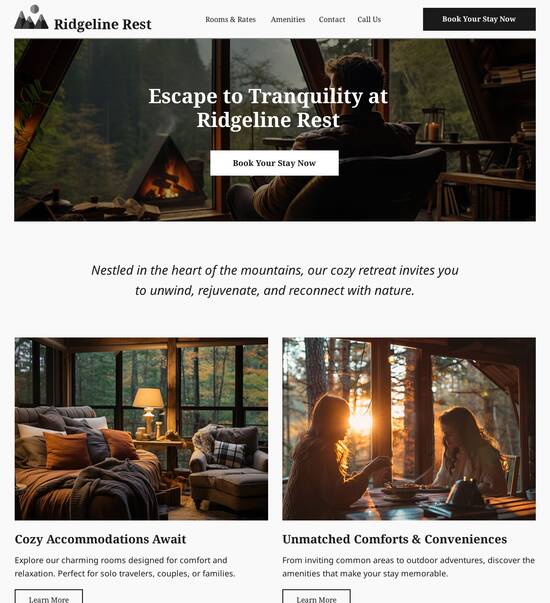
HTML page template for Procurement
Use TemplateAbout template
Conquer your niche with our high-converting landing page templates for your Procurement business. Let's boost conversion rates together!
Recommended templates

Easy to build without coding
With the intuitive drag-and-drop builder, anyone on your team can create high-converting pages without any knowledge of code or design. Make enhancements to your landing page with custom widgets using Javascript, HTML/CSS, or third-party scripts.

Multiple layouts for any industry and goal
Select from 500+ landing page layouts built to boost conversions across industry-specific scenarios. Customize them by adjusting fonts, adding images, and generating on-brand content with the AI assistant. Quickly scale with Instablocks® and Global Blocks that you can save, reuse, and update globally.

Loads fast and looks polished on any device
Every template is responsive, which means they present professionally on any device and load blazingly fast with our Thor Render Engine. You can also power them up with Google AMP technology to deliver an unparalleled mobile experience and drive higher conversions.

Robust analytics & experimentation
Get real-time updates and reporting across all your devices, showing the number of visitors, conversions, cost-per-visitor, and cost-per-lead. Launch AI-powered experiments, run A/B tests, and use heatmaps to analyze user behavior, then optimize your landing page to maximize conversions.







Easy to build without coding
With the intuitive drag-and-drop builder, anyone on your team can create high-converting pages without any knowledge of code or design. Make enhancements to your landing page with custom widgets using Javascript, HTML/CSS, or third-party scripts.
Multiple layouts for any industry and goal
Select from 500+ landing page layouts built to boost conversions across industry-specific scenarios. Customize them by adjusting fonts, adding images, and generating on-brand content with the AI assistant. Quickly scale with Instablocks® and Global Blocks that you can save, reuse, and update globally.
Loads fast and looks polished on any device
Every template is responsive, which means they present professionally on any device and load blazingly fast with our Thor Render Engine.
Robust analytics & experimentation
Get real-time updates and reporting across all your devices, showing the number of visitors, conversions, cost-per-visitor, and cost-per-lead. Launch AI-powered experiments, run A/B tests, and use heatmaps to analyze user behavior, then optimize your landing page to maximize conversions.
All the features you need to build lead-generating landing pages
Explore more featuresLearn how to build top-performing landing pages for any goal
FAQs
Leading the way in building high-performing landing pages





Create Optimized Landing Pages with Instapage
Instapage offers the most powerful landing page and CRO platform for marketers looking to enhance their digital campaigns. With its range of features tailored for both large and small teams, marketers can easily accelerate and maximize the ROI of their campaigns efficiently.
Understanding the Importance of Landing Pages
Landing pages are pivotal in converting traffic into leads. Instapage’s platform allows you to create high-converting pages quickly. By using conversion-focused templates, you can streamline your marketing efforts and capture leads effectively on platforms like Google Ads, Facebook, and more.
- High-Converting Templates: Instapage provides over 100 ready-to-use templates that ensure quick launches while maintaining a high standard of design.
- Lead Generation Optimizations: With built-in lead gen elements, Instapage makes it easy to attract your desired audience.
- Data-Driven Design: Use advanced heatmaps and analytics to see exactly how users interact with your pages.
Steps to Create a Landing Page with Instapage
Creating a landing page on Instapage is simple and user-friendly. Follow these steps to get started:
Step 1: Choose a Template
Start by selecting a high-conversion template that aligns with your marketing goals. Instapage offers diverse layouts for various industries.
- Business Services: Templates showcasing service offerings attract potential clients.
- Education: Educational institutions can use templates to promote courses and enrollments.
- Tech/SaaS: Technology-focused templates capture user interest swiftly.
Step 2: Customize Your Page
Now that you've selected a template, customize it to suit your brand and message. Use Instablocks to build pages without coding.
- Dynamic Text Replacement: Personalize text dynamically based on audience data.
- AdMaps Integration: Align specific ads to unique landing pages for cohesive messaging.
- Customization Tools: Drag-and-drop elements make editing visually intuitive.
By following these steps, you will effectively maximize the potential of your landing pages.
Ready to boost your marketing campaigns? Sign up for Instapage today and start creating optimized landing pages that convert.
People also ask about HTML page template for Procurement
HTML page template for procurement
Understanding the landscape: The significance of HTML page templates in procurement
Procurement processes are vital to any organization looking to acquire goods and services efficiently. HTML page templates play an essential role in streamlining these processes by providing a structured and interactive format. Leveraging HTML templates can lead to greater clarity, enhanced communication, and more efficient workflows.
Unlike traditional document formats such as PDFs or Word documents, which are often static and difficult to modify, HTML page templates offer a dynamic environment. They are designed for interaction, enabling users to fill out forms, submit inquiries, and manage orders seamlessly. As companies seek to optimize their procurement strategies, the adoption of HTML templates can significantly improve operational efficiency.
Overview of HTML page templates
An HTML page template is essentially a pre-designed webpage coded in HTML, CSS, and often JavaScript that can be used as a starting point for various applications. In procurement, these templates can significantly simplify the way teams manage suppliers, track orders, and maintain records. The advantages of using HTML templates extend beyond mere aesthetics; they establish a consistent framework that can save time and ensure accuracy across procurement tasks.
Customization: HTML templates enable customization tailored to specific procurement needs, allowing for unique branding and user experiences.
Accessibility: As web-based tools, HTML templates can be accessed from anywhere, improving collaboration and communication among team members.
Efficiency: With built-in forms and interactivity, HTML page templates facilitate faster order processing, reducing delays and errors.
The functionality of HTML page templates
One of the key features of HTML page templates in procurement is their user-friendly interface. These templates provide intuitive navigation that reduces the learning curve for new users. They can be fully customized based on the unique requirements of each organization, ensuring that procurement processes align with company goals and requirements.
Moreover, HTML templates can integrate smoothly with existing procurement systems, such as ERPs and inventory management tools. This integration capability ensures that data flows seamlessly between different systems, minimizing manual data entry and enhancing reporting accuracy. As procurement needs vary among businesses of different sizes, scalability and adaptability are paramount. HTML templates can grow with the organization, allowing for additional features and components as needed.
Core components of a procurement HTML page template
Designing a procurement HTML page template requires careful consideration of the core components that will house essential procurement information. Effective structuring includes creating sections for supplier listings, item catalogs, and order forms. Each section should be easily navigable, ensuring that users can locate and interact with the information they need efficiently.
Another critical aspect is the incorporation of visual elements, such as icons and charts, which enhance understanding and improve user engagement. These visuals can highlight key data points, making it easier for users to interpret complex information at a glance. Additionally, food forms should include validation mechanisms to confirm that entries are accurate before submission. This level of detail not only improves the ordering process but also builds confidence in the data being collected.
Dynamic elements in procurement HTML templates
Interactive components are a hallmark of effective HTML templates in procurement. These elements, such as dropdown menus, checkboxes, and sliders, allow users to engage actively with the content. Incorporating features like auto-completion for supplier lookups or conditional fields that alter based on previous selections can drastically improve the user experience.
For instance, if a user selects a specific supplier, additional fields may prompt other relevant information, such as pricing or delivery options, relevant to that choice. This level of interactivity not only enhances user engagement but can also lead to fewer errors and faster order processing, thereby streamlining the procurement workflow.
Optimizing page load with iolazy implementation
In the world of HTML templates, site performance can determine user satisfaction and efficiency. iolazy is a library that can dramatically enhance page loading times by implementing lazy loading for images and other heavy resources. By only loading essential content initially, and deferring the rest until the user scrolls or interacts with the page, iolazy optimizes performance without sacrificing the user experience.
Integrating iolazy into procurement HTML templates involves including the library in the head section of your HTML document and implementing it in your image or content elements. This can lead to impressive load speed improvements, decreasing bounce rates and increasing overall engagement with procurement platforms.
Utilizing event listeners for enhanced interactivity
Event listeners in JavaScript allow HTML templates to respond dynamically to user actions. With functions like document.addeventlistener, developers can set up various events to track integral interactions within the procurement page. This includes monitoring click events for order submissions and focus events to enhance form usability.
For example, instant feedback during data entry can improve the user experience by alerting users to errors or prompting necessary information immediately, instead of waiting until form submission. Dynamic updates based on user input can further simplify complex workflows, yielding a more intuitive and responsive procurement environment.
The role of document content loaded (DOMContentLoaded)
Developers must consider the loading process of their HTML templates to ensure smooth interactions. The DOMContentLoaded event signals when the initial HTML document has been completely loaded and parsed, meaning developers should optimize their scripts accordingly. This can help prevent blocking the UI by ensuring scripts run after the essential elements are present.
Best practices suggest deferring or asynchronously loading scripts to enhance performance. By timing scripts efficiently, developers can prevent potential pitfalls such as slow load times or script errors, ensuring the procurement process remains swift and seamless for users.
Enhancing SEO and accessibility
Optimizing procurement HTML templates for search engines is vital for increasing visibility and attracting users. Techniques such as utilizing relevant keywords, enhancing metadata, and providing unique, valuable content can significantly impact SEO outcomes. Incorporating structured data can also help search engines better understand the content on procurement pages.
Equally important is ensuring that HTML templates are accessible. Implementing best practices for navigation, including keyboard navigation and screen reader compatibility, can cater to a wider audience. These inclusivity measures not only fulfill compliance requirements but also enhance overall user experience, making procurement processes more available to everyone.
Real-world applications
Numerous case studies underscore the effectiveness of HTML templates in the procurement arena. Organizations that have adopted these templates report streamlined processes, reduced lead times, and improved communication with suppliers. Tailoring templates to specific industry needs, whether in tech, education, or government, has proven vital for gaining desired outcomes.
Lessons learned from these implementations often emphasize the importance of user feedback during the design phase. By actively involving actual users, organizations can create templates that better meet their needs and expectations. Continuous iterations based on performance and user experience are essential to refining and enhancing procurement HTML templates.
Future trends in procurement HTML templates
Looking ahead, the evolution of procurement HTML templates is likely to be influenced by emerging technologies. The integration of artificial intelligence and machine learning can automate numerous aspects of procurement, from supplier selection to order management. Such innovation holds the promise of not only increasing efficiency but also enhancing accuracy by predicting trends and user needs.
Additionally, we can expect to see advanced features like enhanced analytics, automated compliance checks, and more robust customization options that cater to the rapid pace of change in the procurement landscape. The future of procurement HTML templates looks bright, with ample opportunities for greater efficiency and effectiveness.
Final thoughts on procurement efficiency
In summary, HTML page templates stand out as a transformative tool in the procurement arena, enhancing efficiency and streamlining complex processes. The ongoing trends toward better usability, integration, and user engagement highlight the need for organizations to adapt continually. As procurement technology continues to evolve, embracing HTML templating will likely inform smarter, more responsive solutions that contribute positively to overall operational performance.
Ready to skyrocket conversions?
Supercharge your ad campaigns with high-performing landing pages
Get started














